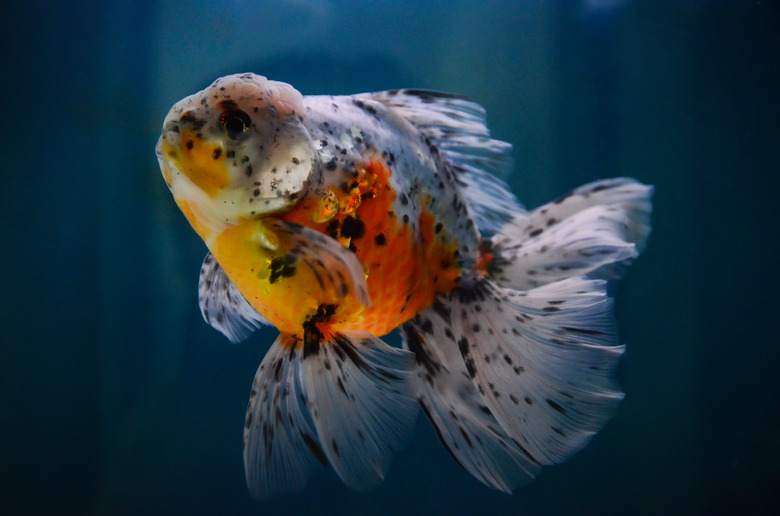How To Tell The Sex Of An Oranda Goldfish
A popular species of fancy goldfish, the oranda is characterized by its flowing fins and bright red bumpy hood that is reminiscent of a raspberry. Sometimes called a bullhead oranda goldfish or a red cap goldfish, male and female fishes look very similar, but close observation of physical features can help you make the determination, and clues become apparent during breeding season.
Oranda breeding season
Oranda breeding season
An oranda goldfish breeds when the water warms in early spring when they are kept in outdoor ponds. However, as the oranda was developed by human intervention, they've lost some of the cold hardiness of wild goldfish species. They thrive best in an indoor aquarium environment with regulated temperatures.
You can determine when your oranda goldfish breeds by giving the fish a cool period to simulate winter — such as turning the tank heater down to 65 degrees — and then gradually increasing the temperature to around 70 to 72 degrees to simulate warmer weather at the rate of about 3 degrees per day.
Breeding male oranda goldfish develop bumps
Breeding male oranda goldfish develop bumps
As breeding season begins, sexually mature males develop bumps on their heads and pectoral fins, known as breeding stars or tubercles. These look like little warts or the raised bumps of braille writing and are no cause for concern. Immature males as well as some females might develop a few here and there. However, a breeding male will develop the tubercles all over his face and pectoral fins.
Female oranda goldfish deposit eggs
Female oranda goldfish deposit eggs
Once your aquarium or pond temperature gets to around 70 degrees, your females will start swelling. Because both the male and female oranda have nearly spherical bodies, it can be unreliable to try to judge gender by body shape before spawning season. As a female swells with eggs inside her, her bumpy, distended belly will reveal her gender.
A female oranda goldfish lays up to 10,000 eggs during a spawning session lasting several hours. The sticky eggs will cling wherever they land, including aquarium decorations, plants, and sides of the tank. A spawning mop mimics natural grasses and will attract your fish to swim through as they lay their eggs. It's easy to remove the eggs to a separate tank for the fry to hatch without being eaten.
Other clues to oranda gender
Other clues to oranda gender
Because these fancy goldfish have such round body shapes, it can be difficult to tell which is a female oranda goldfish when she is not gravid. When viewing your fish from above, females tend to look more asymmetrical in the roundness of their belly.
It's usually not too difficult to see the vent area as the fish swim slowly around the tank. The vent is the area near the anal fin where eggs and feces come out on a female fish, and milt and feces emerge from the male. On oranda goldfish, the female's vent area is rounded outward, while a male's is more concave.
Male oranda goldfish are generally the ones chasing others around the tank. This type of goldfish is generally docile, getting along with his fellow goldfish and spending his time sifting through gravel. When chasing activity starts, it is typically a male chasing a female in anticipation of breeding or chasing a male rival.
Check the fins
Check the fins
The long, flowing fins of the oranda can make it challenging to tell males from females based on fin shape alone. In many types of fish, it's easy to distinguish between the longer, pointed dorsal and anal fins of a male and the short, rounded fins of a female.
With the oranda, you can still get a clue of gender by looking at the front fins. These pectoral fins are shorter and more squarish or rounded on the female fish. On male fish, they will be longer and pointed on the ends.
References
- Build Your Aquarium: Oranda Goldfish Breed Guide: Care, Information, & Pictures
- It's a Fish Thing: How to Tell the Gender of a Goldfish: Top 5 Methods to Sex Your Fish
- ResearchGate: Embryonic and Post‐Embryonic Development of the Ornamental Twin‐Tail Goldfish
- Aquariadise: Oranda Goldfish Complete Care Guide
- Tankarium: Oranda Goldfish – Care, Lifespan, Size, and Other Fascinating Facts
